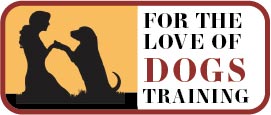Five Questions to Help You Improve Your Dog Training Skills
New clients often tell me “my dog is stubborn,” or “my dog will not listen,” or “my dog is stupid.” When that happens, I ask five questions:
- Are you clearly communicating with your dog?
- Is your method of training positive?
- Are you fair and consistent in your training?
- Do you use the “right” reinforcement for your dog?
- Is everyone at your house on the same page with respect to training your dog?
Just like people, dogs respond well to clear, positive communication. Take, for example, jumping. Your dog LOVES to connect with you and perceives jumping as a way to greet and be close to you. It’s a behavior that is at best annoying and can, depending on the size of your pooch, be downright dangerous. Have you ever spotted an owner kneeing or yelling at a jumper in an attempt to punish their dog into a positive behavior? It rarely works. Instead the dog gets what they want: attention, albeit negative. It’s my pleasure to help you eliminate problems like jumping by showing you how to clearly communicate and train positive behaviors like an iron-clad sit and stay.
Force-based training may work, but it does little to cement a loving bond between a dog and his or her owner. I strongly believe that positive training is the foundation of a successful dog training program. Interestingly, the American Veterinary Society of Animal Behavior agrees. The positive clicker training program I teach my clients produces a fun, dynamic way for owners and dogs to enjoy their time together as they build a strong, loving team. Put yourself in your dog’s paws… Would you rather work for the sound of a click, something yummy and praise, or be punished?
One of the biggest challenges in training a dog isn’t the dog. Yup, you read that right. It is NOT the dog. The hardest, most gnarly part of dog training is the work we must, as owners, undertake to become a fair and consistent pack leader. I can help you develop and refine your consistency as you work to clearly communicate with your pooch. Just so you know, you can expect a lot of help, praise, and positive reinforcement.
Speaking of reinforcement, did you know that it can vary from dog to dog? Some pups like treats; some love car rides; some respond to belly rubs. My particular training method pairs a click with a treat for a desired behavior. I’ve found this approach to be very successful. At the same time, I know it’s important for anyone training a dog to remain open to possibilities. When I interview new clients, I always ask what gives their dog joy. It’s a great way for my clients and me to brainstorm a list of potential reinforcements.
All the work we do with our dogs, the progress we make, can be undone by a well-meaning family member. It’s important to engage everyone at your house in the training process so that you can be on the same page. That way, your dog will get the same clear, positive, fair and consistent message from each family member.
It may seem like your dog is stubborn or doesn’t listen or isn’t all that bright. I’m here to tell you it’s just not true. If you are willing to put in the time to become your best friend’s pack leader – someone who communicates clearly and positively; someone who is fair and consistent – you can realize the dog of your dreams. Oh yeah. You’ll have FUN, too!
